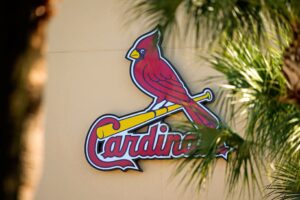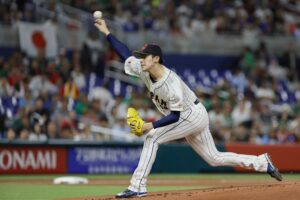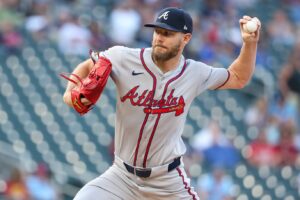After many of the Nationals top prospects have recently graduated from the minor leagues like Juan Soto and Victor Robles, and others have been traded for ML caliber players like Jesus Luzardo, the Washington Nationals are left with one of the weakest farm systems in baseball. The Nationals, normally a team touted for its farm system, were the oldest team in the big leagues last year, with an average age of just over 30 years old. However, the core pieces of the Nationals remain young as they are lead offensively by 21-year-old sensation Soto, and up and coming Robles.
Not all is negative with the Nationals farm system, as they have many lottery ticket players, with the potential to be the next “big prospects”, following the likes of Stephen Strasburg, Lucas Giolito and Bryce Harper.
Washington Nationals 2020 Top 10 Prospects
10. Seth Romero: LHP
Seth Romero was the Nationals first-round selection in the 2017 MLB Draft. Romero, touted as a potential top 10 draftee, slipped all the way to 25th pick in the draft due to the dismissal from the University of Houston after two suspensions. During his tenure in Houston, Romero displayed a mid 90s fastball, accompanied by a power slider, and a developing change-up. Over his three year career in Houston, Romero had a 2.43 ERA, with 290 strikeouts in just 226 IP. Scouts had Romero as one of the most “MLB-Ready” draft prospects. Some Nationals fans were even mentioning the possibility of Romero pitching from the Major League bullpen in the 2017 season.
However, it has been a rough start to Romero’s major league career. He was sent home from the Washington Nationals in 2018 for violating the team policies. There have also been many questions on his conditioning and work ethic. To worsen the situation for Romero, he underwent Tommy John surgery in September of 2018. Since having surgery, Nationals pitching coach Paul Menhart has praised Romero for his rehab process, and being in baseball shape.
Romero looked good in his short stretch in the minors with 69 strikeouts in only 47 IP. After recovering from surgery, Romero projects as a back-end starter or back-end reliever with his fastball and slider combo. Romero’s changeup needs to develop more, as he has two “plus” pitches with a mid 90s fastball and a mid 80s slider. He has a chance to rise quickly through the Nationals system now that he is healthy.
9. Yasel Antuna: SS
The Washington Nationals signed Yasel Antuna when he was just 16 years old out of the Dominican Republic. He was a consensus top 15 international prospect at the time and was signed for a hefty $3.9 million. Antuna has battled injuries his first three years in professional baseball as he missed almost all of the 2019 season with Tommy John surgery. Antuna came on the scene strong in 2017 where he hit .301 and had three triples in the Gulf Coast League. Following a strong rookie season, he was promoted to the Single-A Hagerstown Suns where he struggled, hitting .220 with 79 strikeouts in only 87 games played.
The Nationals are hoping that with Antuna only being 20 years old, and having a full season to recover from Tommy John surgery it will allow him to gain strength and add to his power profile. Antuna is a switch-hitting shortstop, who looks to have a smoother stroke from the left-handed side of the plate. Scouts have been impressed by his raw power, but this has yet to translate in games. With the extra year of growth, they are hoping for an improvement in the power department. Plate discipline is another area where Antuna must improve as he struck out 22.2% in his last full season. Defensively, Antuna is a solid defender at shortstop, but a future move to second base may be in the wings due to the limited range.
8. Israel Pineda: C
Israel Pineda was signed for $450,000 in 2016, the same class as Antuna and Garcia. Pineda, a right-handed throwing catcher, is another one of the Nationals prospects who struggled after being promoted to Single-A, after a strong 2018 campaign. Pineda possesses good size, at 5 ’11 190 lbs, and raw physical tools which can be molded to becoming a quality Major League catcher. In the 2018 season with the Doubledays, he hit .273 with four HR in only 46 games as a broken hamate bone caused him to miss the rest of the season. Pineda struggled in 2019 after being promoted to Single-A, only hitting .217 and 102 strikeouts in 101 games. On the defensive side, Pineda has a solid arm, throwing out 43% of runners, but has work to do on the blocking side, as he had 26 passed balls in 2019.
The Nationals are hoping Pineda can fill the long term void at catcher, as Kurt Suzuki and Yan Gomes are 36 and 32 years old respectively. Even after a disappointing 2019 season, the 19-year-old catcher has all of the tools to be a top five prospect by the end of the year.
7. Andry Lara: RHP
Andry Lara is the Nationals latest prospect to reach the organization’s top 10 list. Lara, signed by the Nationals on July 2nd, 2019 out of Venezuela and possesses a mid 90s fastball and a power breaking ball to complement it. Being 17 years old, Lara has the physical tools as he was a consensus top 20 International prospect in 2019,
Lara has a long way to go in his development, but the blueprint is there for a solid prospect. He will have an opportunity for a MiLB strength program, and add velocity to an already solid fastball, and continuing to develop the changeup will allow for a three-pitch arsenal. Being 17 years old, Lara doesn’t project to be ready until the 2024 season at the earliest.
6. Tim Cate: LHP
The Washington Nationals selected Tim Cate 65th overall in the 2018 MLB draft from the University of Connecticut. Cate possessed one of the best curveballs in the 2018 draft according to many people around baseball. He has a low 90s fastball, along with a developing changeup. Cate draws comparisons to former Nationals starter Gio Gonzalez as he has a looping curveball, with a finesse fastball.
After pitching out of the bullpen in college at times, Cate has been a starter for the Nationals for the past two years. Following a slow start to his professional career, Cate had a magnificent 2019 season where he pitched to a 3.01 ERA across two levels of Single-A with 139 strikeouts in 143.2 innings. The Nationals hope Cate can continue upon this success, and put him into the conversation for the Major League club. Cate projects as a solid back-end starter if he keeps on improving on his command which improved in 2019.
5. Wil Crowe: RHP
Just as Cate, Wil Crowe was drafted 65th overall in the 2017 MLB draft out of South Carolina. In three years at South Carolina, Crowe had a 3.48 ERA in over 235 innings pitched. For the most part, this success has translated over to the minor leagues. In his brief debut in 2017, Crowe had a 2.96 ERA, pitching in the GCL and the New York-Penn League. Continuing on this solid start, Crowe had a 3.40 ERA in 2018, although he struggled late in the season after a promotion to Harrisburg. Last season, Crowe looked solid in Double-A before having a 6.17 ERA in the hitter-friendly Pacific Coast League.
Crowe possesses a solid fastball, which can touch 95 at times, and a “plus” changeup as his best secondary pitch. He needs to continue to command his curveball, and throw it for strikes to complement the solid two-pitch combination above. With a strong 2020 season, Crowe could find himself helping the Nationals later in the year.
4. Mason Denaburg: RHP
Mason Denaburg was the Nationals first-round pick in the 2018 MLB draft. According to a report from MASN, Denaburg was selected after Mike Rizzo talked to Nationals ace Max Scherzer in the draft process. There is a lot to like about Denaburg as he has a mid to upper 90s fastball, and a hard breaking ball that can produce swings and misses. As his changeup develops, Denaburg must be able to throw his curveball for a strike to keep hitters honest.
Denaburg got off to a shaky start in his MiLB career, having 14 walks in just 20 innings. He also had a 7.52 ERA last season. However, being only 20 years old, Denaburg has the potential to break-out this season, and put together all of his physical tools and rise up the Nationals farm system.
3. Jackson Rutledge: RHP
After selecting Denaburg in 2018, the Nationals took Jackson Rutledge in the first round the following year. Rutledge transferred from Arkansas and finished his college career at San Jacinto College. Standing at 6 foot 8 inches, Rutledge is a hard-throwing righty with short arm action. His fastball sits in the mid-90s, with the arm action making it look faster out of his hand. Along with his fastball, Rutledge has a power slider that reaches 90 miles per hour. He mixes in a curveball, with his slider being his best secondary pitch.
Rutledge got off to a strong start in his professional career by having a 3.13 ERA and a .169 AVG against in 2019. He projects as a potential front-line starter, who has the potential to be a top 100 prospect as soon as the 2020 season. The Nationals hope they found a pitcher that can provide youth to their future rotation.
2. Luis Garcia: SS
Luis Garcia signed with the Nationals in 2017 for $1.5 million from the Dominican Republic. Garcia has gotten an opportunity in Spring Training this year and has turned some heads, drawing comparisons to Juan Soto in his approach. Although his bat may never reach that level. Garcia has an MLB ready glove, who can play all around the infield, as he projects as a second base.
Garcia who is just 19 years old, got off to a fast start, hitting .302 and .298 in his first two seasons. However, after an aggressive promotion to Double-A, Garcia struggled last year with an OBP of .280 and only four home runs. One of the major critiques on Garcia’s game is his power, but the Nationals hope that as he continues to fill out his frame, he will improve in this department.
Garcia is hitting .417 this Spring Training and has gotten praise from manager Davey Martinez who alluded to him playing with Trea Turner and Carter Kieboom in the future. The Nationals have been known to be aggressive with their young prospects. If Starlin Castro struggles to start the year, could the Nationals accelerate Garcia? Even if he doesn’t debut this year, Luis Garcia will be a key part of the Nationals future.
1. Cartier Kieboom: SS/3B
Carter Kieboom, the brother of former Nationals catcher Spencer Kieboom, was drafted 28th overall in the 2016 MLB draft out of high school. Kieboom was the Nationals first shortstop drafted in the first round since Anthony Rendon in 2011. Kieboom has hit well in the minor leagues, since his first year of professional baseball. In his first full year in 2017, Kieboom hit .297 with nine home runs in just 61 games. After one year in the minors, Kieboom spent most of last year with the Fresno Bulldogs, hitting .303 with 16 home runs. In between this stretch, he had a rough 11 game audition at the Major League level. After being called up to replace Brian Dozier in late April, Kieboom hit just .128, had 16 strikeouts, and four errors in his short spurt in the big leagues.
Despite that rough stretch, Kieboom is in position to be the opening day third basemen this year as he battles with Asdrubal Cabrera for the starting spot. Kieboom projects to be an above-average bat in the middle of the order, who has the power to hit 20 homeruns. However, Kieboom must improve defensively if he wants consistent playing time. Kieboom does not project as a shortstop due to his limited range. He has been introduced to third base this Spring after playing second base last year. This Spring Kieboom has looked better, hitting .250 with a .417 OBP, but still looks stiff playing third base. If Kieboom can put the skills together, he could be a nominee for NL Rookie of the Year.
Main Image
Embed from Getty Images






